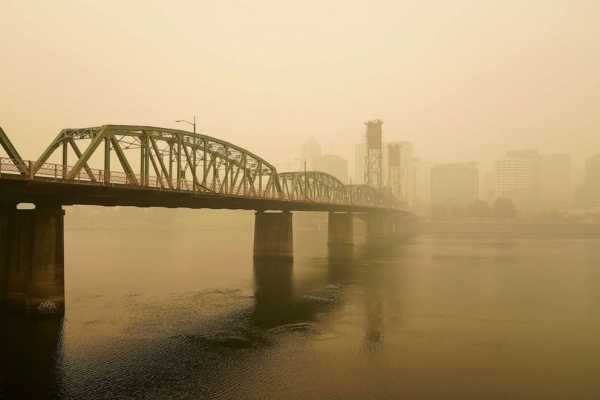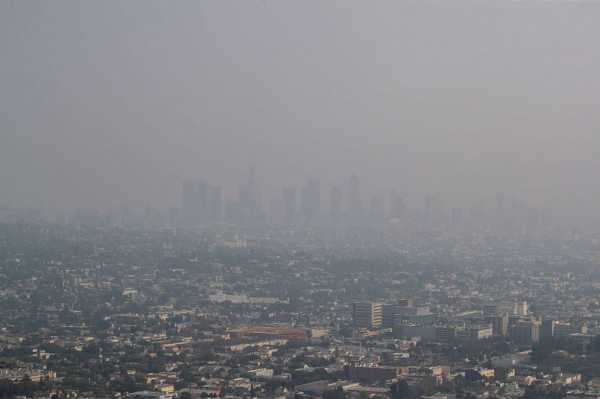More than one-third of Americans live in places with unhealthy levels of air pollution, according to an annual report published by the American Lung Association. The 24th iteration of the State of the Air report determined 19 million fewer Americans live in these areas.
Unhealthy levels of pollution were defined as receiving a failing grade for one of the three metrics.
The annual report looked at three air quality measures: Particle pollution, broken into daily averages and daily spikes, and ozone levels, which are tracked by the Environmental Protection Agency (EPA).
As defined by the report, particle pollution, also known as soot, is a mixture of tiny bits of solids and liquids in the air that can come from many sources that emit fine particles. Sources can include factories, power plants, motor vehicles, and burning of wood, including forest fires.
Ozone, also known as smog, is a gas compound composed of three oxygen atoms that is formed in the lower atmosphere when pollutants, often from burning fossil fuels, interact with sunlight and heat.
"120 million people were living in places that got unhealthy grades, but that's quite a bit fewer than we saw last year, and that's largely because we've seen improvements in ozone air pollution which is really good news," says Katerine Pruitt the national senior director for policy at the American Lung Association.
MORE: Almost half of Americans breathing more unhealthy air than ever before: Report

The downtown skyline and Hawthorne Bridge as smoke from wildfires fills the air in Portland, Ore., on Sept. 16, 2020.Rebecca Smeyne/Bloomberg via Getty Images, FILE
Since the initial publication of the annual report, there has been a shift of the most polluted cities from the East Coast to the West Coast. This has been attributed to the improvement in ozone pollution and the rise of particle pollution.
"Because we've seen improvements in ozone air pollution which is really good news. Ozone air pollution is still the most widespread of the pollutants that we track," said Pruitt. "On the flip side of that is particle pollution, which is continuing to get worse. And we found that the number of people living with unhealthy levels of fine particle pollution has almost doubled in the last five years."
Pruitt credits the drop in ozone pollution to the improving standards and regulations following the Clean Air Act.
Unfortunately, these positive impacts have been negated by climate change in the West.
"The impact of climate change is undermining the progress that's been made," Pruitt told ABC News. Wildfires have also been a driving force in the shifting to air pollution.
MORE: Only 13 countries and regions achieved normal air quality standards last year: Report

The view of downtown Los Angeles skyline is obscured by smoke, ash and smog as seen from the Griffith Observatory, Sept. 14, 2020 in Los Angeles.Allen J. Schaben/Los Angeles Times via Getty Images, FILE
"I can tell you that in California, where I have been practicing more frequently for the past 25 years because of the wildfire smoke 20 years ago, maybe 20 to 30 days of the year, you would expect to have coverage of wildfires. Now it's about 100," said Dr. Kari Nadeau, John Rock Professor of Climate Science and Population Studies and Chair, Environmental Health at Harvard University, and Allergy, Asthma, and Immunology clinical specialist, who currently practices in both California and Massachusetts.
"Ozone in particular can make asthma worse, but it has also been shown to increase the risk of cardiovascular disease, increase the risk of stroke and increase the risk of premature birth," Dr. Nadeau said.
"People with preexisting lung disease like asthma and COPD definitely can experience exacerbations that require them to use more medication to open their airways and it can also lead to them going to the emergency department, or even getting hospitalized," said Dr. John Balmes, professor emeritus of pulmonary and critical care at the University of California- San Francisco and a spokesperson for the American Lung Association.
Americans can learn more about the air quality in their own communities by visiting the EPA website AirNow.gov or download the AirNow.gov app.
Sourse: abcnews.go.com






